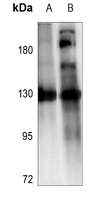Anti-ZO3 Antibody
Rabbit polyclonal antibody to ZO3
- SPECIFICATION
- CITATIONS
- PROTOCOLS
- BACKGROUND

Application
| WB |
|---|---|
| Primary Accession | O95049 |
| Other Accession | Q9QXY1 |
| Reactivity | Human, Mouse, Rat, Dog |
| Host | Rabbit |
| Clonality | Polyclonal |
| Calculated MW | 101397 Da |
| Gene ID | 27134 |
|---|---|
| Other Names | ZO3; Tight junction protein ZO-3; Tight junction protein 3; Zona occludens protein 3; Zonula occludens protein 3 |
| Target/Specificity | KLH-conjugated synthetic peptide encompassing a sequence within the center region of human ZO3. The exact sequence is proprietary. |
| Dilution | WB~~WB (1/500 - 1/1000) |
| Format | Liquid in 0.42% Potassium phosphate, 0.87% Sodium chloride, pH 7.3, 30% glycerol, and 0.09% (W/V) sodium azide. |
| Storage | Store at -20 °C.Stable for 12 months from date of receipt |
| Name | TJP3 |
|---|---|
| Synonyms | ZO3 |
| Function | TJP1, TJP2, and TJP3 are closely related scaffolding proteins that link tight junction (TJ) transmembrane proteins such as claudins, junctional adhesion molecules, and occludin to the actin cytoskeleton (PubMed:16129888). The tight junction acts to limit movement of substances through the paracellular space and as a boundary between the compositionally distinct apical and basolateral plasma membrane domains of epithelial and endothelial cells. Binds and recruits PATJ to tight junctions where it connects and stabilizes apical and lateral components of tight junctions (PubMed:16129888). Promotes cell-cycle progression through the sequestration of cyclin D1 (CCND1) at tight junctions during mitosis which prevents CCND1 degradation during M- phase and enables S-phase transition (PubMed:21411630). With TJP1 and TJP2, participates in the junctional retention and stability of the transcription factor DBPA, but is not involved in its shuttling to the nucleus (By similarity). Contrary to TJP2, TJP3 is dispensable for individual viability, embryonic development, epithelial differentiation, and the establishment of TJs, at least in the laboratory environment (By similarity). |
| Cellular Location | Cell membrane; Peripheral membrane protein; Cytoplasmic side. Cell junction, tight junction. Nucleus. Note=Exhibits predominant nuclear expression in proliferating cells but is exclusively junctionally expressed after confluence is reached (PubMed:23608536). Shows an epithelial-specific tight junction localization in a TJP1/TJP2- dependent fashion (By similarity). {ECO:0000250|UniProtKB:Q9QXY1, ECO:0000269|PubMed:23608536} |

Thousands of laboratories across the world have published research that depended on the performance of antibodies from Abcepta to advance their research. Check out links to articles that cite our products in major peer-reviewed journals, organized by research category.
info@abcepta.com, and receive a free "I Love Antibodies" mug.
Provided below are standard protocols that you may find useful for product applications.
Background
KLH-conjugated synthetic peptide encompassing a sequence within the center region of human ZO3. The exact sequence is proprietary.
If you have used an Abcepta product and would like to share how it has performed, please click on the "Submit Review" button and provide the requested information. Our staff will examine and post your review and contact you if needed.
If you have any additional inquiries please email technical services at tech@abcepta.com.













 Foundational characteristics of cancer include proliferation, angiogenesis, migration, evasion of apoptosis, and cellular immortality. Find key markers for these cellular processes and antibodies to detect them.
Foundational characteristics of cancer include proliferation, angiogenesis, migration, evasion of apoptosis, and cellular immortality. Find key markers for these cellular processes and antibodies to detect them. The SUMOplot™ Analysis Program predicts and scores sumoylation sites in your protein. SUMOylation is a post-translational modification involved in various cellular processes, such as nuclear-cytosolic transport, transcriptional regulation, apoptosis, protein stability, response to stress, and progression through the cell cycle.
The SUMOplot™ Analysis Program predicts and scores sumoylation sites in your protein. SUMOylation is a post-translational modification involved in various cellular processes, such as nuclear-cytosolic transport, transcriptional regulation, apoptosis, protein stability, response to stress, and progression through the cell cycle. The Autophagy Receptor Motif Plotter predicts and scores autophagy receptor binding sites in your protein. Identifying proteins connected to this pathway is critical to understanding the role of autophagy in physiological as well as pathological processes such as development, differentiation, neurodegenerative diseases, stress, infection, and cancer.
The Autophagy Receptor Motif Plotter predicts and scores autophagy receptor binding sites in your protein. Identifying proteins connected to this pathway is critical to understanding the role of autophagy in physiological as well as pathological processes such as development, differentiation, neurodegenerative diseases, stress, infection, and cancer.


